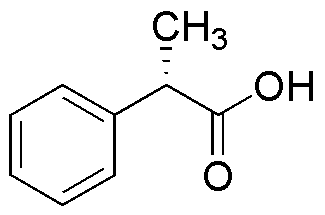(S)-(+)-2-Phenylpropionic acid is widely utilized in research focused on:
- Pharmaceutical Development: This compound serves as a key intermediate in the synthesis of various non-steroidal anti-inflammatory drugs (NSAIDs), providing pain relief and anti-inflammatory effects.
- Chiral Synthesis: Its chiral nature makes it valuable in asymmetric synthesis, allowing chemists to produce specific enantiomers that are crucial in many biological applications.
- Food Industry: Used as a flavoring agent, it enhances the taste profile of certain food products, making them more appealing to consumers.
- Cosmetic Formulations: This compound is incorporated into skincare products for its anti-inflammatory properties, helping to soothe irritated skin and improve overall skin health.
- Research in Organic Chemistry: It is a useful reagent in various organic reactions, aiding researchers in exploring new synthetic pathways and developing innovative chemical processes.
General Information
Properties
Safety and Regulations
Applications
(S)-(+)-2-Phenylpropionic acid is widely utilized in research focused on:
- Pharmaceutical Development: This compound serves as a key intermediate in the synthesis of various non-steroidal anti-inflammatory drugs (NSAIDs), providing pain relief and anti-inflammatory effects.
- Chiral Synthesis: Its chiral nature makes it valuable in asymmetric synthesis, allowing chemists to produce specific enantiomers that are crucial in many biological applications.
- Food Industry: Used as a flavoring agent, it enhances the taste profile of certain food products, making them more appealing to consumers.
- Cosmetic Formulations: This compound is incorporated into skincare products for its anti-inflammatory properties, helping to soothe irritated skin and improve overall skin health.
- Research in Organic Chemistry: It is a useful reagent in various organic reactions, aiding researchers in exploring new synthetic pathways and developing innovative chemical processes.
Documents
Safety Data Sheets (SDS)
The SDS provides comprehensive safety information on handling, storage, and disposal of the product.
Product Specification (PS)
The PS provides a comprehensive breakdown of the product’s properties, including chemical composition, physical state, purity, and storage requirements. It also details acceptable quality ranges and the product's intended applications.
Certificates of Analysis (COA)
Search for Certificates of Analysis (COA) by entering the products Lot Number. Lot and Batch Numbers can be found on a product’s label following the words ‘Lot’ or ‘Batch’.
*Catalog Number
*Lot Number
Certificates Of Origin (COO)
This COO confirms the country where the product was manufactured, and also details the materials and components used in it and whether it is derived from natural, synthetic, or other specific sources. This certificate may be required for customs, trade, and regulatory compliance.
*Catalog Number
*Lot Number
Safety Data Sheets (SDS)
The SDS provides comprehensive safety information on handling, storage, and disposal of the product.
DownloadProduct Specification (PS)
The PS provides a comprehensive breakdown of the product’s properties, including chemical composition, physical state, purity, and storage requirements. It also details acceptable quality ranges and the product's intended applications.
DownloadCertificates of Analysis (COA)
Search for Certificates of Analysis (COA) by entering the products Lot Number. Lot and Batch Numbers can be found on a product’s label following the words ‘Lot’ or ‘Batch’.
*Catalog Number
*Lot Number
Certificates Of Origin (COO)
This COO confirms the country where the product was manufactured, and also details the materials and components used in it and whether it is derived from natural, synthetic, or other specific sources. This certificate may be required for customs, trade, and regulatory compliance.


